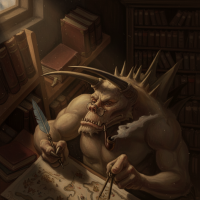Style Request: East Asian Floorplan/Dungeon
I was thinking about Himeji Castle. There are a couple of style available that can be used to do the outside. I can show the castle walls with their tops. I can show any garden paths. What I can't show is anything inside. Since there are already a couple of city scale maps, I thought it would be nice to have a map style for the interiors.
Tagged:






Comments
That's a very good idea.
I usually end up using third party content for Asian themed dungeons and floorplans - which usually prevents me from publishing the maps, because of licensing issues.
An Asian Dungeon / Castle style would be awesome.
I'm currently very busy working on Forest Trail part 1 and 2 for the November and the Bonus issues 2022, so I won't have any time to do anything new until 2023, but it is an interesting idea.
Something I realised very quickly, though - what exactly constitutes an Asian-themed dungeon style?
I mentioned the dungeon because I know that floorplans are usually in the dungeon section. If the floorplans work for say doing a room in a castle, then perhaps a dungeon map would be the ruins of a castle. I think having unique walls would help. Japanese castle walls are built differently than European ones. Their stones also have a particular look. There would be wooden walls. Rice paper doors and decorative wood and panels. Some of what you would do is just add on/do improved versions of what are in the other styles.
One of the things that disappoints me about the current maps is that the top down nature leaves out so much of the interior detail. I am not sure there is a way to fix that unless you do a side angle map.
https://www.pinterest.fr/pin/337629303289386055/
https://www.pinterest.jp/pin/553168766715393307/
One thing that could be done is a style change to make it feel Asian. So you would still have cave or stone walls, but they are done in a way to evoke East Asia.
I like Francesca Baerald's work for L5R. I am not a fan of her dungeon maps, mostly because they don't seem very useful. However, maybe these will give you some inspiriation on how to do your own style.
https://www.artstation.com/artwork/qAvlBa
And the click on the Daylight Castle Map here: http://www.francescabaerald.com/dungeon-battlemaps/
And since you tend to add animals, you can add deer, oni, Asian style dragons, foxes, fox demons, monkeys in hot springs, etc.
Thanks for doing the footwork.
Yes, the usual top view type of map is not the best view to show a style that is largely about the walls. However, the more useful map styles are top view, simply because they are practical.
Is there nothing you can think of that would be typically Asian from above? It's the question I've asked myself. Maybe it's in the colour scheme, or the type of furniture? I don't know enough about Asian culture to say.
And yes - Francesca is a very talented artist. I remember when she first appeared not that many years ago at the Cartographer's Guild ;)
Maybe a style for Perspectives?
Never done a Per style before. Are they useful in games?
I've used them for battle maps, but not often - it's harder to just throw one together quickly.
I've used them more often as visual aids to help players visualize a scene, or just for my own fun.
I've intended to try combining a Perspectives scene with a DAZ figure, but haven't so far...
Hello Sue,
I somewhat agree with @JulianDracos
What I would like as an "Asian dungeon style" would be more of a floor plan style - since dungeons do not vary as much as buildings:
For example: A Japanese "Samurai-Era" - style with:
A style in which we could map a Samurai castle/ outpost, a peasant village or a corrupt merchant's house which our Ninja need to infiltrate. Or something in which we can draw floor plans for our Asian towns.
The symbols and textures in the "regular" dungeon styles just lack a lot of specific "old asian-themed" things.
I would prefer a "top-down dungeon-style" to a perspectives style. However, I can understand the appeal of "Asian" walls for perspectives.
Oh I see!
Well, I think I do anyway.
You might have to help by linking to image examples of actual things, like these floor textures, straw mats, fireplaces and so on. and what do you mean a crawl space entry?
As you might have gathered, I'm a not very well travelled westerner. In fact I've been to France once, and that was it (if you don't count the several cross-channel sailing races to Cherbourg and back that I crewed on).
Don't worry. Me neither. Only left Europe twice, and one of these occasions was crossing the bridge to "the Asian Side" in Istanbul. :-)
Here's an Article that covers some of the concepts and has a few very good photos:
Oh dear! It doesn't like Ad-blockers, but I am an aspie and adverts destroy my concentration, so I can't read that one at all.
Hmmm... here's two good images from the article, that should give a good first impression:
Also check your PM. ;)
Thanks :)
I should be able to find more material myself now, but don't take that as read that it will become a style. There has to be enough material and enough demand for it.
Got it. Thank you for taking a look.
Are perspective maps useful? Yes. I think a main benefit in the 3d nature permitting one to see the relationship between floors. I think a main benefit is being able to show what is on walls. This permits creating a feeling. It is also imporatnt to remember being use CC3 to create maps for publications so these can be more artistic. Notice that Francesca is the person who does all of L5R maps. They are always done in a top-down angled way similar to perspectives. If I am doing a room or a corridor, then I think it works well. Look at the Egyptain Tomb here: Profantasy's Map-Making Journal » Blog Archive » Perspectives 3 full release
Ignoring the perspectives option and just focusing in on items:
Flooring - often wood. Ceder is pretty typical of a type of wood. They have narrow wooden staircases.
Flooring - Tatami mats
Partition Japanese On Room Tropical Interior With Tatami Mat Floor And Ganite Tiles Wall3d Rendering Stock Photo - Download Image Now - iStock (istockphoto.com)
Bedding - Futons were the most popular choice. It was just think bedding rolled out. No furniture will it.
https://en.wikipedia.org/wiki/Futon#/media/File:Sleeping_two,_Kasuga_Gongen_Genki_(1309).jpg
They had small rectangular pillows
Sitting - Most Japanese sat on the floor, so pillows are important. Zabutons: https://en.wikipedia.org/wiki/Zabuton#/media/File:Japanese_chair_and_armrest.jpg
Since people sat on the floor, then chairs had no legs. These would be wooden and usually lacquered. You will have many pillows. Nobles would have a raised area above the floor where they would sit.
Sunken hearths are common. A area where the ground is lowered so that fire could be set for warmth/cooking.
Tansu Chests for storage:
Room divider screens are heavily used. You have see through wooden ones:
Antique Japanese 4 Panel Wood Folding Screen Room Divider | eBay | Folding screen room divider, Room divider, Folding screen (pinterest.com)
Or paper:
Japanese Room Divider Shoji Rice Paper 4 Panel Traditional Natural - Fine Room Dividers
Or really fancy ones:
Asian room divider/ screen C.1920 | Anemone | Asian room, Room divider screen, Divider screen (pinterest.com)
Items:
Tea sets
Saki glasses
Outdoor lanterns: What Are Toro? Discovering Traditional Japanese Lanterns (japanobjects.com)
Indoor paper lanterns.
I will have to think some more on this.
Some of you might check the Atlas as I have several isometric dungeons in there. I don't think CC3+ is 3D capable for now.
Isometric building and room maps can look good for players, but they're often a nightmare for GMs trying to run an adventure, where you need to know exactly where everything in a room is at a glance, and how it connects to everything else in its vicinity. A top-down map gives you that control, plus for players, they can see instantly where everything is too, as battlemaps, for instance.
Iso can have its uses for a GM though, where flat wall features (such as carvings) might be important, say, though that may need several views so all walls can be identified and seen clearly.
Slightly concerned that "East Asian" seems to be being redefined as just meaning "Japan" here, given Japan's a tiny fraction of East Asia overall. Might be better to retitle this topic as referring to Japan only? Or expand the discussion to include features from China, Mongolia, the Koreas, Taiwan and perhaps places adjacent as well?
Plan view styles also contain a wider range of assets because you only have to draw each thing once, instead of 4 times.
Don't worry. If I end up doing something like this, it will most likely follow the Japanese Temple and Japanese Village convention and be called something beginning with "Japanese". East Asian is a category that is far too diverse to be done in a single style anyway. You would need at least 10 or so.
EDIT: Actually I realise now that one of those styles was Asian Town, but that one was much less specific than the Japanese Temple style. With something as specific as this it would have to be "Japanese..."
I was actually thinking more about the topic title than what the style might contain, Sue, in case someone's trying a search in future for something for elsewhere in East Asia than Japan.
Love this idea. I think it could be potential for 2023 - a FB topic would gets lots of hits for this style :)
The previous style names are Asian Town and Japanese Temple. While I have posted about Japanese, this is just a starting point. If @Loopysue wants to do this style and only wants it to be Japanese, I can rename the thread. On the assumption, she could do it more general, then I think it would be easy if you stick with top down. While there are differences between various countries, it is going to show up in ways you won't usually see from top down, e.g. different dress, different colors, different ways of building, different artistic techniques, different materials, different decorations, etc.
Bamboo: China and South East Asia use bamboo for furniture and some building, but Japan did not.
China: Assuming we are thinking roughly medieval (so mostly Ming Dynasty but you could go as far as Qing then:
Chairs - Unlike Japan, they have chairs with legs by this point. They also have couches.
Given they have chairs with legs, then you have larger tables and desks:
https://upload.wikimedia.org/wikipedia/commons/6/66/Ming_Furniture_02.jpg
You will also have raised canopy beds:
Flooring: While Japan has tatami mats, China had dirt for poor, wood for most, and stone for government and wealthy households.
Weapons/Armor: While Japan has the katana, Chinese would use Jian https://upload.wikimedia.org/wikipedia/commons/d/d0/Sword_with_Scabbard_MET_DP119025_brightened_2x3.jpg
and Dao
Chinese armor varied far more than Japanese in terms of style/material. It really depends on the area of China and which dynasty. The Ming has plate armor: https://upload.wikimedia.org/wikipedia/commons/7/77/%E6%98%8E%E6%9C%9D%E5%85%A8%E9%90%B5%E7%94%B2_%2851586713536%29.png
and then we have leather
Chinese tend to have more dragons and shi-shi dogs. Japan has more fox statues. Each Japanese household would have a personal shrine in the house.
I think you could do generic fantasy Asian. For example, Avatar the Last Airbender.